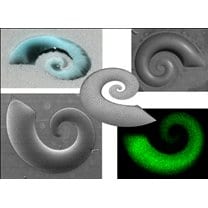 Droplets can be designed in a specific shape and pattern, by using a technique developed by US scientists. The resulting patterned surfaces could be used to control cell growth and movement as well as to make new nanocomponents.
Droplets can be designed in a specific shape and pattern, by using a technique developed by US scientists. The resulting patterned surfaces could be used to control cell growth and movement as well as to make new nanocomponents.
Surface patterning is important in many areas of modern technology, from cell growth and movement to assembly of tiny electronic devices or components. While there are plenty of methods for achieving such patterning by either so-called top-down or bottom-up approaches, most such approaches do not allow multiple concentrations of nanoparticles to be patterned directly onto the same surface, which is desirable because microgradients on a surface can be used to control movement of cells and other small particles across the surface.
Scientists at Harvard University and Massachusetts Institute of Technology, USA, led by Ali Khademhosseini, have addressed this need by developing a new method that allows them to control the shapes of micro- and nano-sized droplets. They pattern a surface with special hydrophilic and hydrophobic regions and then add droplets onto the surface. The patterned regions define where the droplets are able to spread and hence also their shapes and depths. The droplets can contain a suspension of particles, and a deep droplet can contain more suspended particles than a shallow one. When the solvent is removed the contents will be left deposited on the surface; the effect of this is that the scientists can control the concentration of particles deposited, and thus produce surface gradients. The technique can also be used to deposit varied cell concentrations, and to produce any number of highly intricate nanopatterns.
The team also used their technique to produce finely shaped microgel patterns on a surface. This time, they started with droplets of a polymer solution which they deposited on the patterned surface then cross-linked using light. Microgels formed largely in the 3D shape of the initial droplets deposited.
All of these patterns can be pre-designed and therefore the eventual shape of the droplets defined by using finite element method simulations, which are commonly used in engineering design already. This calculation gives the scientists a high degree of control over what 3D shapes they can make.
Khademhosseini and his team are full of ideas for their promising new technique. Their surface gradient patterning could be used to control cell growth, attachment, and shape, and to induce cell movement; such applications should be of great use to those studying everything from neuronal cells to bacteria. The droplet-shaping technology could also be used with conventional top-down patterning methods to allow ever more complex nanoshapes to be produced for use in the devices of the future.

















